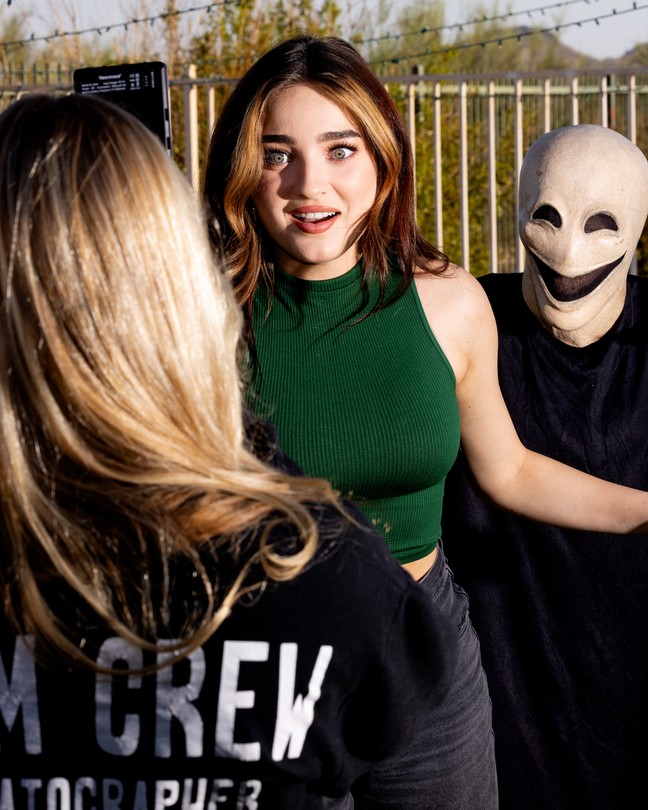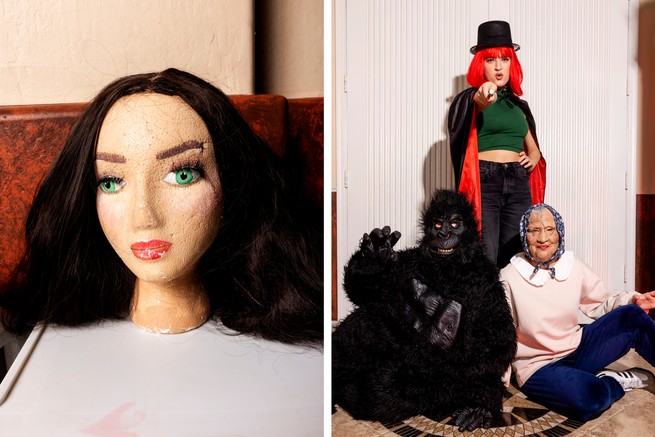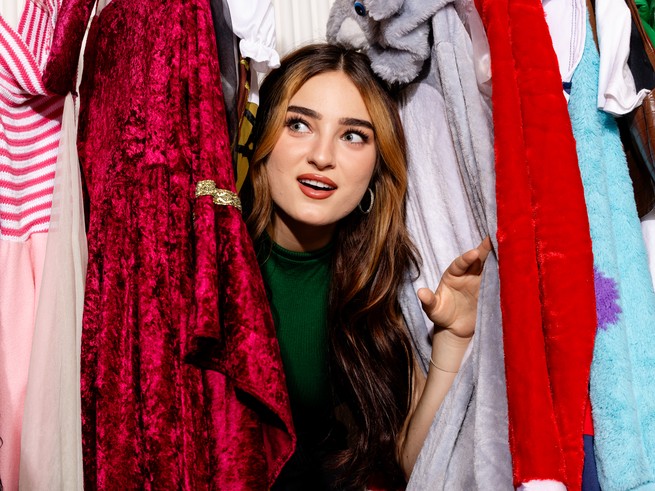Life in the Fever-Dream Business
9 min read
A typical film by Savanah Moss runs about 30 seconds long and costs maybe $300 to make, and yet somehow each feels like a full-body plunge into a surreal alternate universe. Many of them end in the same place they begin, and so on TikTok, where she has 11.4 million followers, they loop around and around, like a fever dream. That’s what she calls them: fever dreams. And as in dreams, plot is mostly beside the point.
She posted a film this summer captioned “I found out where the missing socks go…” It begins with Moss botching a pirouette inside a grungy RV, then sloppily pouring a jug of milk into a glass. “Goodnight,” she says. “Don’t let the bedbugs bite.” The camera whips around to an actor in a pillowy bedbug costume—the sweetest giant bedbug you’ve ever seen—holding a fork and knife, frowning, thwarted. Now we’re back inside the RV, Moss’s POV, and a black wraith charges toward the camera. Moss hides under a quilt, and someone (or something) outside the frame pulls a sock off her foot to reveal a wiggling hand that gives a thumbs-up. The culprit turns out to be a cardboard washing machine. “Freeze!” Moss calls out. The startled washing machine puts up its hands, and Moss slams it behind the bars of a jail cell. She spots a maple-frosted donut inching along the floor (“Ooh, maple!”) and tries to capture it with an oversize “emergency spoon” that she yanks off the wall. She dives, misses, and lands in a forest, where the washing machine (how did it escape?) welcomes her. “Are you a sock?” asks an all-white figure with a crown and scepter who stands in front of a tree with dozens of missing socks dangling from its branches. “You don’t belong here,” the figure says. Someone dumps a laundry basket filled with socks over Moss’s head, and now she’s back in the RV, under the bed covers. In the film’s final shot, the bedbug is back, sitting beside her on the floor, taking a chomp out of a severed leg. The end.
What does it all mean? Who cares! Moss’s films are funny and freaky, playfully innocent with a sinister undercurrent. Taika Waititi, the Oscar-winning director of Jojo Rabbit and Thor: Ragnarok, became a fan after Marvel hired Moss to make some fever dreams promoting its films. Another Hollywood admirer is Damon Lindelof, the Emmy-winning co-creator of Lost, The Leftovers, and Watchmen. “I was immediately struck by the DIY energy and the sheer audacious creativity,” Lindelof told me: “the deadpan silliness mixed with the avant-garde weirdness. Her stuff feels to me like it’s what David Lynch would be doing if he was Gen Z.”

Moss is 25 and lives in the suburbs north of Phoenix, a safe remove from the industrial complex of thirsty social-media influencers in Los Angeles, who pile into rental homes and try to game the algorithms. She started making videos during high school but got serious about it while taking classes at a local community college and stacking shelves at an Ulta makeup store. She films her fever dreams at her parents’ house or at a playground in a local park. She made a lot of them in a Walgreens parking lot, until fans figured out where it was and kept showing up during shoots. Sometimes she’ll rent an escape room if one of her ideas requires a location that would be too expensive or time-consuming to build. And the brand partnerships come to her: DoorDash, L’Oreal, State Farm. She has made fever dreams to promote the new Dr. Strange movie, Spider-Man: Into the Spider-Verse, and the malevolent stuffed-teddy-bear thriller Imaginary.
She could easily afford shinier production values, but she prefers to stick with her handmade approach. It’s playful but spooky, like an old stuffed animal that’s missing an eyeball. “I like more of a rough look,” she told me. “It feels more authentic; that is a conscious effort.” Despite her youth, she’s managed to develop a fully realized visual style, something that many veteran filmmakers with a career’s worth of experience never achieve. Within two or three seconds, you know you’re watching what could only be a Savanah Moss production.
Last winter, The New York Times culture critic Jason Zinoman featured her on his “Best Comedy of 2023” list, calling her “a cheerful young Arizona absurdist” and comparing her, again, to Lynch. “Watching her slowly but prolifically develop a distinctive handmade visual vocabulary gives me hope for this digital medium,” Zinoman wrote. Lynch, in fact, is one of Moss’s favorites. Like him, she explores the hidden surreality of suburban malaise. Jugs of gushing white milk have become a leitmotif—in one film, she pours milk out of a hole in a basketball. She told me her “fridge is always filled with it.” She often casts herself as a Starbucks barista in a green apron, or a Subway sandwich maker. But then she’ll fling together the ingredients in a pile, smash the sandwich with her elbow, shove it in a toaster, and pull it out frozen inside a brick of ice.
If you’ve spent any time surfing videos on social media, you know what a wasteland it is out there. The most popular online creators traffic in pranks and stunts, the trickle-down effect of Mr. Beast’s omnipresence, and the rest is a gloppy stew of recycled memes and dancing videos—zone-out material built for the sole purpose of keeping the thumb scrolling. Using the snack-size videos on platforms such as TikTok and Instagram for actual self-expression is a radical concept.
And yet Moss has developed a style that seems to maximize the platforms’ creative possibilities, turning their limitations into virtues. When there’s no barrier to entry, why spend a fortune on production? When you’ve got only 30 seconds or so to work with, why bother with traditional narrative? Unlike with feature films and series television, there are no formal expectations. Moss is working with a blank slate.
At first, Moss tried becoming a social-media influencer like every other Gen Z would-be creator with a cameraphone. Inspired by the early YouTube sensation Emma Chamberlain’s funny, chatty, vloggy style, she made her own copycat versions that were, she now says, “horrendous. Those are long gone. No one will ever find those.” The first time a video of hers went quasi-viral was in 2019: Moss in her bathroom, dangling by her waist over her shower rail. “That hurted,” she wrote in the caption. For reasons that only teenagers can explain, the clip was a hit, so she upped the ante, dangling herself over the jutting poles of a metal fence. That hurted even more, but it didn’t work. So she moved on to stunts and pranks—baking brownies on the dashboard of her car during a scorching Phoenix afternoon; building a tall tower of red Solo cups in the living room; trying to get a friend to bite into a water balloon shaped like a hot dog. She managed to accrue a modest following, but she was bored.
She wanted to try making videos full-time, but her parents objected. “I actually said, ‘Why don’t you get a real job like everyone else?’” Moss’s mother, Connie, told me. “I was totally against it.” But in 2021, Moss made a new kind of video: a strange, late-night lampoon of a cheerfully inept Starbucks drive-through barista. An off-camera customer asks Moss for milk, she holds up a cup and a waterfall of milk pours into it from above, splashing everywhere. Her smile never breaks. She hands it over; leaves a wet, white palm print on the car door’s window sill; then botches a pirouette, landing on her butt. It’s been viewed more than 63 million times. (The pirouette-and-fall has become another Savanah Moss staple.)
“Exceptional customer service,” as she titled it, is a rudimentary version of the fever dreams she makes now, but it unlocked something in her imagination. The film played less like a spoof and more like a flickering dream about a surreal encounter. Moss’s mother describes her as “quiet, very shy, really not outgoing,” but in this clip, her full personality—quick-witted, pun-loving, comedically klutzy—came bounding out. If you scroll back through her posting history, there’s a clear line of demarcation: The conventional influencer stuff was now in her past. Her audience exploded, and she began landing promotional deals. “That’s when I realized, Well, gee, she makes more money at this than stocking shelves at Ulta,” her mom told me.
The fever dreams are now a family business. Savanah’s 19-year-old twin sisters, Hanna and Haily, are crew members. Hanna is her cinematographer, and when you see someone wearing a Pillsbury Doughboy suit or a chicken costume, or pouring milk from the sky, or lurking ominously in the background in a slasher mask, that’s usually Haily. She’s the prop master, the stunt double, the best supporting actress. Technically, Moss is also their mom’s boss. The Mosses own a real-estate company, and Connie is a loan servicer. After a long stretch balancing her daughter’s books for free, she gave Savanah a life lesson in entrepreneurship and asked to be paid: “I just said, ‘This takes some hours here, miss, so I might as well be on your payroll too.’”

Lindelof says that watching Moss’s fever dreams reminds him of the movies he and his childhood pals made with nothing but a camcorder, and he seems confident she’ll soon wind up where he has—in Hollywood, working on a much grander scale. But is it dismissive, maybe even insulting, to suggest that being a wildly successful TikTok auteur must be only a stepping stone to a more conventional career? Moss has found a home in a community of creators who make films in a similar absurdist spirit, such as Zach King, whose “magic videos” filled with trompe l’oeil visual effects have attracted more than 82 million TikTok followers, and Jericho Mencke and Grant Beene, frequent collaborators on madcap buddy-comedy misadventures. She’s making lots of money goofing around at night with her little sisters. She could keep at this for years.
Yet she told me that she is itching to broaden her canvas. Can she sustain her surrealist handcrafted approach to filmmaking across a 15-minute short film? A full-length feature? Or will something that works for 30 seconds grow exhausting if she stretches it too much longer? So much of her appeal comes from the way her creations feel like outsider art. She writes all her scripts in a notebook, listing props in one margin and characters in the other. They look more like annotated diary entries than screenplays, and are mostly inscrutable to anyone but her; it’s worked so far because she’s the only person who needs to read them. Recently, though, she started teaching herself how to work with screenwriting software, and she’s using it to write a standard-length short film, a horror movie that she hopes to post on YouTube later this year. “I always want to level it up,” she told me.
She’s already visiting Los Angeles regularly for partnership meetings, fancy events, and auditions for acting jobs beyond her own creations; she has performed in student films and wants to do more—anything to get her foot in the door. She often wonders if she should’ve moved already. Maybe next summer, when her lease is up and her sisters are ready to come with her. It’s hard for her to imagine doing this without them, but it’s even harder to imagine staying in Phoenix for much longer.
Wherever she goes, she has no interest in changing her aesthetics or vision. The goal, she told me, is always to make people think: “What am I watching right now? Let me watch it again. I’m so confused. But in a good way—a good confused.” Los Angeles is filled with empty parking lots, and enough milk to keep her in the fever-dream business forever.



